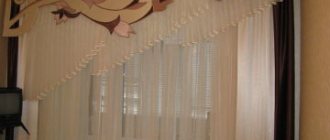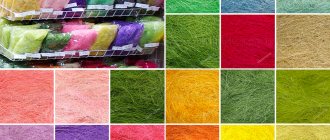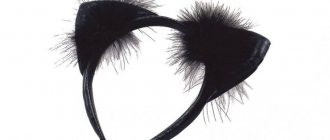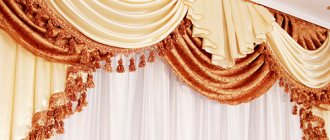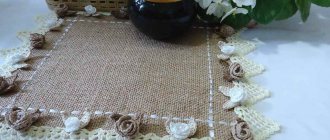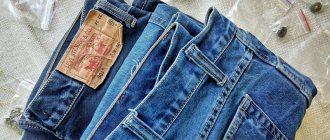Tulle flowers are a decoration that can visually transform any, even the simplest curtains. Such products add elegance to the curtain and make it truly unique, since what you make yourself cannot be bought in any store.
Curtain decor
From this article you will learn how to make flowers from old tulle with your own hands. We will look in detail at the sequence of steps for making roses, asters and lotuses, and also find out where such decor can be used.
DIY organza flowers
Bows and flowers made from organza always look very festive, and it’s especially nice when they are made by yourself. In this article we will get acquainted with master classes on making organza flowers from simple to complex levels, with the addition of other materials.
Master class 1: how to make a simple organza flower?
- organza;
- circle pattern;
- scissors, candle, needle and thread;
- multi-colored beads.
- Using the template, apply circles to the organza and cut them out. The number of circles depends on the expected size of the flower.
- Carefully singe the edges of the circles above the candle.
- We select contrasting beads to match the color of the petals, add all the circles together, moving each circle a little to the side, and sew on the beads, threading a needle and thread through all layers of organza.
By using organza of different colors, we can make various beautiful flowers.
Master class 2: organza rose
- organza;
- circle patterns of different sizes;
- scissors, candle, needle and thread;
- multi-colored beads.
- Using organza templates, we cut out circles of different sizes and make five cuts on each.
- We scorch the edges with a candle, making sure that the edges curl in one direction, and stack them on top of each other as the size decreases.
- We sew all the layers together, sewing several beads into the middle and our rose is ready.
Master class 3: voluminous flower made of organza and satin
- white organza and satin;
- circle patterns with petals of different sizes;
- scissors, candle, needle and thread;
- big bead.
- Using the prepared templates, we cut out parts from organza and satin.
- We burn the parts along the edges with a candle flame.
- We collect the entire flower, alternating satin petals with organza petals of the same size.
- We sew all the layers together, sewing a large bead in the middle of the flower.
Our volumetric flower made of organza and satin is ready.
Master class 4: kanzashi flower made of organza.
- organza ribbon 12 mm wide;
- middle;
- glue, needle and thread.
- We cut 6 organza ribbons of 10 cm each. Fold them as follows: the first time - in half along the length, the second - in the width, and the third - again in length, so that it turns out as in the photo.
- We put the resulting blanks on the needle one by one.
- We pull the thread through them, tighten it in a circle and tie it.
- Having straightened the flower blank in a circle, we begin to form the petals, giving them volume.
- We glue or fasten (if there is a fastening) the middle to the resulting flower.
To make fuller flowers, you need to make more petals.
Master class 5: flower bow with organza elastic.
- white organza;
- circle templates with a diameter of 11 and 14 cm;
- scissors, candle, needle and thread;
- large bead or stone, hair elastic.
Progress:
- From organza we cut out 5 circles of different sizes (11 and 14 cm edges are melted. We fold each of them in half with the wrong side inward and sweep along the edge, retreating up to 5 mm.
- By tightening the thread, we collect the fabric into a petal. We fasten the thread and cut it.
- We string 5 identical petals onto one thread and collect them into a ring. We get 2 blanks, different in diameter.
- We sew the blanks together along the inside.
- On the outside of the flower we sew a large bead or stone to the middle, and on the wrong side - an elastic band.
- For beauty, between two tiers of petals, you can tie thin organza ribbons and our elastic band is ready!
In order not to melt the edges of the parts every time, such flowers can be made from floral organza, since it does not fray after cutting.
Very beautiful flowers can be made from other materials, for example, nylon or felt.
Types of curtains by material:
Which is better, veil or organza?
It is impossible to answer the question unequivocally: which fabric is better. The thing is that there are fundamental differences between these materials, which means, depending on the circumstances, preference will be given to either a veil or organza.
When choosing a material, you should be guided by taste, the purpose of the room, and material capabilities.
- Strength. The veil loses to damage-resistant organza.
- Softness. The veil is unrivaled; it allows you to create soft flowing folds. Organza, on the contrary, is very rigid in structure. The drapery is large.
- Transparency. Organza wins.
- Care. Organza does not require special care; even serious stains can be easily washed off. The veil is a more demanding material; when washing, damage and creases may occur.
For well-lit rooms, a veil is more suitable.
Depending on the interior, it is recommended to choose:
- A gentle and romantic style will harmoniously complement voile curtains;
- For a kitchen space with the prospect of all kinds of dirt and stains, it is better to use organza;
- For children's rooms, where active games are planned and the curtain may be damaged, organza is better suited;
- Transparent organza is indispensable for rooms with insufficient lighting; a veil, on the contrary, is an ideal option for protecting from light.
In rooms where tulle can be easily damaged, it is better to use organza.
Tulle
The types of tulle are: organza, veil and mesh. Let's try to evaluate these fabrics according to an important criterion: the ability to pass air into the room. The veil and mesh win this competition by a wide margin. When choosing tulle for a room, it is worth considering the purpose of the room and the characteristics of the fabric.
Curtains for the living room made of chocolate organza.
Such curtains visually increase the space.
The photo shows a white tulle veil with a satin finish in the interior of a bedroom or living room. Neutral wall decoration and light furniture will complement the concept. The colors of organza are varied and this allows you to create a unique interior, embodying bold ideas.
Living room curtains made of lightweight fabric look stylish and attract attention.
Microveil
Microvoile is the undisputed leader among fabrics in lightness and transparency. This material successfully combines the softness of a veil with the strength and light transmission of organza. This know-how allows you to make the interior not only beautiful, but also functional.
Delicate micro-voile curtains with a floral pattern will decorate a window in a typical apartment and visually expand the room.
Although microvoile allows you to create a variety of complex curtain designs, long, lightly draped fabrics that extend to the floor remain very popular. Microvoile features bright prints. In the photo there is a curtain in pink and purple tones, repeating the color of the wall decoration.
This model gives the interior status.
Rubber bands with flowers
Tools and materials
- organza (width 2 cm) – 170 cm (or organza (width 2.5 cm) – 210 cm);
- green grosgrain ribbon (width 2.5 cm) – 15-20 cm;
- center for a flower;
- mini flowers from FOMA;
- stamens;
- felt base (diameter 3 cm);
- rubber;
- needle;
- scissors;
- threads;
- grosgrain ribbon (width 6-12 mm) – 5 cm;
- colorless monofilament;
- felt;
- hot melt adhesive.
Step-by-step production
- We measure 8 centimeters of tape. Cut it in half. We process the edges with a lighter.
- Fold the piece in half and fold the corner.
- We collect the tape onto a thread. It turns out to be a petal. We do this for 21 petals.
- From the finished petals we glue 3 layers - from five, seven and nine petals.
- We connect the layers and glue them together. It turns out to be a flower.
- We place the decoration on felt in the middle and use monofilament thread for sewing. You can place the decoration on glue.
- We make leaves from green ribbon. We measure 6 centimeters, fold it in half. We cut off the edge and use a lighter to smooth the edges. We wrap it and the leaf is ready. We also glue the leaves.
- We prepare the base, make 2 cuts in it. Attach an elastic band to the glue. We thread the base and elastic through the ribbon, securing the product. Glue the ribbon onto glue.
- We glue the base to the flower, simultaneously gluing leaves and other decorations as desired.
Video instruction
Watch this video to learn how to make your own veil and organza flowers. The author of the video will tell you how to make beautiful elastic bands from a material called organza. It is also used to make other accessories, such as a brooch or a hoop. Enjoy watching!
Length and window decoration with voile curtains
Due to their lightness and soft texture, voile curtains can be secured to the cornice using loops, magnets, and clips. The most popular option for decorating windows in the hall is a duet of curtains made of a veil and a lambrequin. Two-color compositions made of soft lambrequin and curtains look especially organic.
Designers offer different ideas for using products:
- Frill is the simplest option, in which the lambrequin along the entire width of the window opening is gathered into small folds using curtain tape. This is an excellent option for decorating the interior of a studio apartment in Provence and country styles.
- Folding is a fashionable technique in which a single strip of veil is placed in shallow folds and thrown in a certain way over the string. The use of two-row and even three-row crossovers is very often practiced. Such lambrequins look organically with drapes and curtains.
The veil is ideal for forming voluminous lambrequins. Stylists create spectacular aristocratic coattails or exquisite puffs that organically complement smooth transparent curtains.
Organza wreath
Tools and materials
- organza ribbon (width 2 cm) – 5.5 m;
- satin ribbon (width 2.5 cm) – 60-70 cm;
- stamens (yellow, white);
- felt;
- wire (diameter 0.8-1 mm) – 50-55 cm;
- floral tape.
Step-by-step production
- Take wire and floral tape. Create 20 flowers from ribbon. We take 20-22 centimeters of material for one flower. We process the cuts with a lighter.
- Fold the edge of the tape back and stitch it with thread.
- We wrap the long edge of the tape back away from ourselves.
- We collect the folded tape onto a thread.
- We form a flower by pulling the thread. We decorate as desired with various decorative elements.
- You can make leaves for the flowers. To do this, cut off a small piece of green tape. Fold it in half, take it by the edge with tweezers and cut off a corner.
- Using a lighter, glue the parts together and form a leaf.
- Glue the leaves to the flowers using glue.
- Take the wire and wrap it with floral tape.
- We cut out small circles with a diameter of 1.5 centimeters from felt. Using these bases we attach the flowers to the wire.
- We twist the wire into a circle, on one side we “plant” the flower on glue, on the other we fix the base also on glue.
- We do this with all the flowers. We thread the ribbons through the wreath and tie a bow.
Video instruction
Watch this video to learn how to make your own fabric flowers. To make it work, you should study this video. You don't need any photos - everything in the video will be more than accessible and understandable for beginners. Enjoy watching!
Large organza flowers
Tools and materials
- flower templates;
- paper;
- organza;
- scissors;
- glue;
- needle;
- wire;
- pencil;
- clothespins.
Step-by-step production
- Fold one A4 sheet into four and cut it.
- Fold one rectangle in half and draw half of the petal.
- For the middle petal, fold the A4 sheet in a vertical position and draw half of the petal. For a large template, take an A3 sheet, fold it in half in a vertical position and cut off half of the petal, cutting off about 8 centimeters from the top.
- We fold the organza in several layers. We choose different shades. We attach the template and cut out 12 small petals, 12 medium ones and 12 large ones.
- We form the first row of petals using one wire. Glue the wire into the middle of one petal and cover it with another petal. Trim the petals to the desired shape.
- We bend the wire to form leaves.
- We connect all the small leaves together and bend them into the shape of a flower.
- For the middle templates we do the same, but at the same time we glue not one wire, but three. We glue one in the middle, the other two - along the edges. We cut off the excess. We form the petals and glue them together. To create large petals, you can use 4 wires.
- We put all the parts together.
Making flowers from curtains: master class
To make flowers from tulle, fabric of any shade is suitable, but we recommend using milky white textiles and coloring them during the creative process with batik paints or acrylic paint.
This way you will get a soft transition of tones, visually bringing the handicraft closer to a living flower.
The technology for coloring tulle petals for any craft is the same:
- Cut out the required number of flower elements;
- We lower it into clean warm water for 4-5 seconds;
- Place the petal on the glass and press it against the work surface with a terry towel to remove excess moisture from the fabric;
- We take the paint and dilute it with water or alcohol to get a soft, less saturated shade;
- We paint the petal creating a gradient transition - from a rich color in the lower part to a light, airy shade in the upper part (you can paint it in an equally intense tone, but the gradient can literally revive a flower made of chiffon or organza). If desired, we add additional shades to the main color - there are no restrictions here, use your imagination;
- To make the product dry faster, transfer it with tweezers to a cotton towel;
- To fix the color after dyeing, iron the workpieces at minimum iron power through a newspaper.
To make flowers from tulle for curtains with your own hands, prepare in advance all the necessary tools and materials:
- Cardboard and pen (for patterns);
- Sewing accessories - needles, threads, scissors, ruler, pliers;
- Light fabric - organza, tulle, chiffon;
- A candle (for finishing the edges of the petals) or a soldering iron for burning fabric;
- Silicone glue;
- Beads for decoration.
We have sorted out the preparatory stage - we begin to make crafts from tulle with our own hands.
Lotus
To make a lotus from tulle, we also need a piece of felt fabric, which we use as a dense base for the petals.
Sequence of making textile lotus:
On thick cardboard we draw the dome-shaped outlines of a large and small petal - this is the blank on which we will cut out the tulle.
If you are making a flower for the first time, stick to the specified dimensions - in the future, as you gain experience, you can experiment with the dimensions of the products at your discretion.
We lay the blanks on the tulle
We lay the tulle on a hard surface, place the blank on it and cut out the petals using a fabric soldering iron. In this case, we make the lower cut oblique; we will need an additional section for sewing the petal to the base.
Cutting out the petals
We need 24 large and 6 small petals.
Finished blanks
Next, we trim the lower contour of the petals at an angle as in the photo.
Trimming the bottom outline
We need 24 large and 6 small petals.
Cut out 3 even strips of tulle measuring 40*5 mm
Cut out 3 straight strips
We give the petals a shape - squeeze the workpiece in the middle with your finger so that the edges of the corner cut meet, fix the petal with pliers and, using a soldering iron or a drop of glue, secure the upper parts of the petal at the point of contact.
Take the blank Squeeze it in the middle with your finger Fix the petal with pliers Finished petals
We cut out a circle with a diameter of 5 cm from felt fabric and begin to sew lotus petals to it.
Cut a circle with a diameter of 5 cm from felt fabric
The first three layers are large petals (8 pieces on each), the last are small (6 pieces).
The first three layers are large petals
Place each subsequent layer on top of each other so that the petals are placed closer to the center of the lotus.
Place each subsequent layer on top of each other
We decorate the middle of the flower with beads.
Beads We decorate the middle with beads
We attach a bead on each side of the ribbons we have prepared and sew them to the underside of the lotus
Sew ribbons with beads to the wrong side
That's all - the beautiful homemade lotus is ready.
Ready flower
Aster
You can make an aster from old tulle using tulle, which is used as a rigid backing for the petals, making the flower voluminous and expressive.
We will need four rectangular pieces of tulle of similar size (40*25 cm) and 2 pieces of tulle fabric.
Fabric for flower
We cut out the required pieces of fabric and lay them on top of each other: tulle on top, tulle on the bottom. Next, we assemble the textiles into an accordion with a distance between the folds of 2 cm.
Having assembled the accordion, we bend it in the center and secure it with a thin rope.
Assembling an accordion
We use scissors to process each fold of the workpiece - cut it at an angle so that the aster takes on an interesting shape.
Bend along class=”aligncenter” width=”700″ height=”453″[/img] Cut at the corners
All that remains is to form a full-fledged flower from the blank - straighten the tulle around the circumference so that the aster gets a round shape. At the same time, the folds will disperse and become less dense.
We straighten the tulle around the circumference
Tulle holds its shape well, so you shouldn’t have any problems with it. Next, lift the tulle layer up.
Raise the tulle layer up
We form neat petals, evenly distributing the tulle around the circumference of the aster.
Forming neat petals
If the tulle is poorly fixed in a given position closer to the base of the flower, secure it with a drop of glue.
Ready-made flower
To make an aster from tulle with your own hands, you don’t need a lot of time and effort - it’s an easy-to-make flower, which, at the same time, looks very beautiful.
Rose
DIY organza roses are also not difficult to make. We recommend using thick organza as it holds its shape and lends itself better to drape.
First of all, you will need to cut square blanks for petals measuring 3-4 cm.
Square blanks
Next, we cut out round petals from the blanks; for a three-dimensional rose, you need about 25 of them.
Cut out round petals
We process each petal with a soldering iron or burn it on a candle so that it does not fray over time. Do this carefully, removing the fabric from the fire immediately after its edges begin to melt.
Burn on a candle
To keep the petals in shape, coat them with hairspray and let the fabric dry for 5-10 minutes.
Varnish
We make flowers from tulle - we pull the first petal together and secure it with a stitch at the bottom.
We tighten the first petal and fix it with a stitch at the bottom
We cover the first petal with the next blank and secure them with a thread to each other.
We fix the second and first
In the same way, we continue to increase the volume of the rose until it becomes quite lush.
We continue to increase the volume
The result is an elegant flower that closely resembles a real rose.
Ready rose
Making flowers for curtains with your own hands (20 photos)
When you want something new, but there is no time to update your usual interior (and in general it is expensive). When the room lacks comfort and warmth. Then flowers for curtains will be a great solution. Made with your own hands, these cute and practical accessories will be the pride of any housewife.
Let's consider all kinds of options for making flowers: from fabric for curtains, ribbons and other materials; from the simplest (but no less impressive) to complex compositions that will not leave anyone indifferent.
Felt flowers
This is the simplest decoration option. This material does not fray and therefore does not require edge processing. All you need is to decide on the type of fabric. Felt can be from 1 to 2 mm. thick, soft or hard. The second holds its shape better, so products made from it seem “drier.” But from soft felt more delicate “petals” are obtained. Korean and Spanish fabrics are considered the best among needlewomen.
To make a “rose,” you need to cut the workpiece in a spiral and then assemble it in the center with simple stitches and strong thread. Like this example.
For a “chrysanthemum” you can cut out each “petal” separately and then also collect them in the center.
Features of voile curtains
Beautiful appearance, transparency and lightness determine the popularity of the veil. The texture of the fabric resembles a fine mesh net. Any thin fabric obtained by plain weaving can be called a veil. Previously, flax, cotton, wool or silk fibers were used to create lightweight textiles. The basis of modern veils is a combination of artificial and natural fibers.
It is easy to highlight the advantages of voile curtains:
- the soft structure allows you to drape the fabric into elegant and smooth folds;
- Products embroidered with silk or decorated with appliqué and guipure elements look original;
- designs made from several layers of textiles are an excellent opportunity to decorate a window opening in the shape of an arch in a non-standard way;
- thanks to the rich color palette and original designer patterns, it’s easy to choose curtains that visually expand the space;
- acceptable prices;
- Curtains are easy to care for and replacing fabrics is not difficult, which is why delicate voile curtains are also made for children's rooms.
Naturally, products made from veils also have some negative qualities: multi-layer structures quickly accumulate dust, bright fabrics lose color over time, and some stains are difficult to remove from the fabrics.
Products made from organza deserve special attention: the fabric perfectly transmits light and has a soft shine. Surprisingly thin, durable textiles (microvoil) are easy to drape.
DIY printed flowers for curtains
Grips made from voluminous flowers sewn from simple cotton fabrics look cute and spontaneous. Such decorations are not suitable for curtains in a classic living room or curtains for a kitchen, but they will look wonderful in a nursery.
For such work, one cannot do without a pattern - a paper blank for the future “petals” and “core”. It should be taken into account that when stuffing, the length and width of the product becomes smaller, so you should immediately make an allowance for volume - from 0.5 to 2 cm.
To get parts from fabric, you need to place a paper pattern on the material folded in half (to make the front and back parts of one part of the flower at once) and cut out the parts with a seam allowance along the edge (from 0.5 to 1 cm).
Each part is stitched separately, turned right side out and loosely filled with padding (sintepon, cotton wool, etc.). The “core” connects the remaining parts and is sewn on by hand.
At the end of the work, the flower is attached to the tape - the curtain grip is ready.
How to choose colors for combined voile curtains
When choosing shades, first of all, the style of the room and the desires of the owners to see the environment as calmer/neutral or, conversely, multi-colored, are taken into account.
Classic interiors require good lighting in spacious living rooms. Curtains are sewn from plain fabrics of similar shades (white/golden, pink, cream). A bright edging will add bright notes, but will not make the interior overly saturated with colors.
Furnishings designed in modern styles (minimalism, high-tech) are decorated with combined curtains (brown/gold, silver/gray). The turquoise/green duet looks more rich. Textiles in rich colors will transform the laconic mood of living rooms in an original way.
Interiors decorated in rustic styles will be decorated with curtains in pastel blue, pink, sand, and lavender shades. Bright purple and blue patterns will bring fresh notes.
The most delicate flowers: chiffon and organza
It is difficult to cut out small parts from thin synthetic fabrics, since the edge of the product begins to crumble quite quickly. The problem is solved if you burn the sections with a candle or cut out the parts not with scissors, but with a burning apparatus.
To process the edge of the “petal” with a candle, you need to bring the fabric part to the bottom of the flame and quickly cut it so that the threads melt. If everything is done quickly, the fabric will not turn black or burn, and the part will take on a slight concave shape, like the petal of a real flower.
Buds and bouquets made of satin ribbons
Having mastered the techniques of making flowers from kanzashi-style ribbons, you can make wonderful decorations for curtains.
The easiest way is to fold a “leaf” out of a square. To do this, fold the fabric in half once and again. The workpiece is assembled with small stitches along the cut line. The result is a rather voluminous part. For a flower you may need 10 - 30 pieces.
A more complex technique involves folding the tape step by step at an angle of 45 degrees. The base is assembled with thread. You can duplicate the main tape in a different, contrasting color. This is how “melange” buds are obtained.
Still, the easiest way is to gather the satin ribbon with simple stitches along one edge and pull the thread at the end. If you carefully lay the assembly in a spiral, you get a “chrysanthemum”. Or fold the flower like a bow.
Flowers made from floss or yarn
Knitting lovers will love this method. Schemes for work can be selected depending on the level of skill or invented by yourself.
It should be remembered that the thinner the threads, the neater the finished product will look on the curtains.
Jacquard curtains in the interior
Jacquard curtains do not lose their relevance due to their durability and luxurious appearance. Even the most laconic interior is transformed if the window opening is decorated with this exquisite material.
The design of curtains and drapes can be different.
To the hall
For the hall, curtains are selected depending on the style of the interior. Jacquard feels most comfortable in a classic design. Luxurious furniture and gilded decorative elements are suitable company for him.
Noble brown and its variations are always in fashion.
A harmonious combination with elements made of plain fabric in the same color scheme. The decorative braid along the edge and the volume of the design serve as additional decoration for the curtains. Light tulle adds completeness to the model.
Gray color is invariably popular, especially if the pattern on the canvas is made with silver thread. In addition to the jacquard curtains, an interesting decoration of the opening was chosen.
It looks luxurious and noble.
A jacquard voile with a stripe pattern sits on top of the curtains. This non-standard solution is popular, as it allows you to appreciate the beauty and elegance of the curtains even with the curtains closed.
This ensemble in one color scheme looks simply amazing!
To achieve maximum harmony of the “curtains + curtains” set, you can use thick jacquard for curtains and a jacquard veil as tulle.
To the bedroom
It just so happens that bedroom curtains are chosen in pastel colors. This is a kind of axiom. However, jacquard materials skillfully argue with this statement.
The veil does not prevent the penetration of sunlight, which has a positive effect on mood.
As an option, decorate the bedroom in brown tones. This palette does not look gloomy and tasteless at all. On the contrary, thanks to clever accents (bedspread, pillows, wall decoration in brown tones), the bedroom becomes unusually cozy and pleasant.
And light shades have their place.
In this case, the color of the curtains is repeated on the bedspread and pillows.
Well, if there is no need for thick curtains, you can limit yourself to a jacquard veil. Floral patterns and delicate colors are an excellent choice for the bedroom.
Pastel jacquard curtains with a white veil and multi-tiered curtain design will appropriately complement the interior in a classic style.
Voile curtains for the bedroom add lightness and grace to the room.
To the kitchen
Fortunately, the times when housewives tried to hang the most unpretentious curtains in the kitchen have sunk into oblivion. Today, the kitchen is a stylish room where a woman wants to feel like a queen even while preparing dinner. And the curtains are designed to enhance these sensations.
The design of curtains made from this material allows you to embody the most daring ideas, creating unusually beautiful interiors.
An interesting and bright design solution: purple jacquard curtains as a bright accent against the background of light walls. A painting on the wall and modern lamps enhance the effect.
Lightweight canvases of different colors and asymmetrical shapes will help make the window in the kitchen unique in its kind.
When designing a window opening, you should observe conciseness and moderation.
Another model for a small kitchen window. Curtains made of voile of different colors and textures. The delicate color harmonizes with the color of the decor and furniture. Photo wallpaper is a decorative element that completes the overall design solution.
Bell flowers with bias binding
From fairly dense fabrics you can sew original decorations for a lambrequin - a cascade of flowers in the shape of bells. You will need:
- fabric (for a “flower” 10 cm long you need a 10x10 cm square);
- bias binding (about 25 cm for one “bell”);
- wire and beads (beads) for making “stamens”.
One flower detail looks like a birch leaf and is cut from fabric without seam allowances. The cut is trimmed with bias tape. The edges of the workpiece are joined together to form a “cup”.
Beaded stamens look good in such “flowers”. To make them, you need 3 pieces of thin wire, each 10 cm long. Beads or beads are strung on each piece 7-8 cm. After which they are connected together and sewn into the middle of the “bell”.
For the cascade, “flowers” made of fabric are sewn in several rows onto a ribbon and decorated with “leaves”, also trimmed with bias tape.
From polymer clay
One of the most difficult and expensive methods is making flowers from plastic. Crafts made from light, self-hardening polymer clay seem to be the most realistic, but products made from materials that require firing are more durable.
From plastic you can make a brooch or a curtain grabber in the form of a whole necklace of “flowers”. As a rule, each of the “petals” is molded separately, and then they all need to be glued to the base or to each other.
Organza - fabric description
Organza was previously made from silk, then from viscose. Modern manufacturers use polyester thread - the fabric is transparent and weightless, but at the same time rigid and holds its shape well.
This is ensured by tightly twisting two threads together, and depending on their thickness and color, different types of fabric are obtained:
- matte or shiny,
- gradient or chameleon,
- plain or rainbow
- with spraying of various colors,
- with jacquard pattern or embroidery;
- tape of various widths.
Not every fabric is suitable for making flowers. For example, organza with embroidery is used to sew curtains or dresses. Matte and shiny plain fabrics are the most popular among needlewomen.
Matte fabric looks discreet and noble
Shiny organza is a favorite material for flowers on bows, hair decorations and brooches
Spectacular flowers for bright outfits are made from coated organza.
Sprayed organza looks festive, and flowers made from this fabric would be appropriate in a bride’s outfit
For romantic looks, fancy flowers made of gradient organza, chameleon or patterned fabrics are suitable.
Gradient organza is great for fantasy looks
Organza chameleon - for complex, iridescent colors
Gradient colored ribbon produces charming flowers that can be used to create bouquets, including embroidered ones.
A cute summer look will be complemented by a patterned organza flower.
It’s easy to create organza flowers with your own hands – the main thing is to know the basic techniques. For this purpose, Krestik has prepared a review of simple master classes.
Incredible cascades of flowers
The most unusual, but at the same time the most energy-intensive decoration option is to make curtains consisting entirely of flowers. Most often, a strong thread (for example, twine) or fishing line is taken as a basis, onto which several “buds” and “leaves” are attached one after another.
Such complex work requires a large amount of materials. But the following can be used: fabrics, beads, beads and even paper. To prepare for a significant event, you can even take fresh flowers. Such beauty, of course, will not last long, but the extraordinary photos from the holiday will delight you for a very long time.

